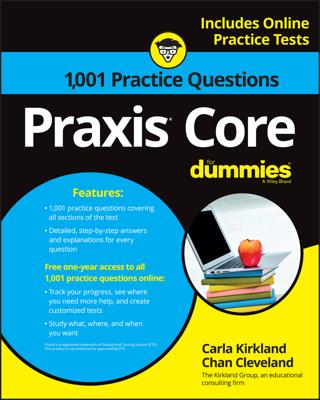Knowing how to perform certain types of math operations is a big part of solving problems correctly on the Praxis Core, but it isn’t everything. Caution is also important. Avoiding common math errors involves both. Keep these common errors in mind on test day.
Misusing negative signs
In our observations, math mistakes occur most frequently when negatives are involved. When you see a negative sign, you should turn your level of caution up a notch or two. Such a small symbol has so much power to transform a quantity.
Imagine being told that you have $1 million in a bank account and then being told, “Oops, you have –$1 million. You are that much in debt.” It’s a completely different picture.
Multiplying by an odd number of negative factors results in a negative product, and multiplying by an even number of negative factors results in a positive product. Also keep in mind that the sum of two negatives is a negative and the sum of a negative and a positive has the sign of the number with the greater absolute value.
Confusing perimeter and area
Remember that perimeter is the distance around something. If it is expressed in units, it’s expressed in one-dimensional units, such as meters (m), centimeters (cm), feet (ft.), and inches (in.).
Area is two-dimensional. It is the amount of a plane inside a two-dimensional figure. When area is expressed in units, the units are two-dimensional and have an exponent of 2. Such units include m2, cm2, ft.2, and in.2.
The perimeter of a circle is also called the circumference. Mixing up the formula for circumference with the formula for the area of a circle is common. Both formulas involve only π, r, and 2, but in different arrangements. The formula for the circumference of a circle is C = 2πr. The formula for the area of a circle is A = πr2.
Incorrectly combining like terms
Only like terms can be combined, and terms have to meet certain conditions to be like terms. They have to either have no variables or have exactly the same variables with the same exponent per corresponding variable.
When no variable is shown with an exponent, its understood exponent is 1. 5xyz and 4xyz can be added to get 9xyz, and 4x2y3z4 can be subtracted from 5x2y3z4 to get x2y3z4. However, 5x2y3z4 + 4x2y3z5 can’t be simplified because the two terms are not like terms. z does not have the same exponent in both terms.
Messing up when moving decimals
Some really common math errors involve calculations and rewritings that require moving a decimal to the right or left. The two major areas of math that entail decimal movement are using scientific notation and converting between decimals and percents. Both involve doing something and then making up for it by undoing it.
Multiplying by a multiple of 10 can be done by moving a decimal to the right and dividing by a multiple of 10 can be accomplished by moving a decimal to the left.
Not solving for the actual variable
Solving an equation or inequality involves stating what a variable equals or could equal. A mistake people commonly make is saying what something that almost looks like a variable could equal. For example, you may think an equation is solved by the conclusion –x = 15. That’s not a solution.
To solve for x, you need a statement about x at the end, not –x. Solving for x is all about the value of x. Your final statement must be about what x equals, not about what 3x, or 1/x, equals, for example.
Misrepresenting “less than” in word problems
When an operation is described with English words instead of mathematical symbols, part of your challenge is to represent the operation correctly. The most common mistake made in doing that is incorrectly representing a certain amount less than a number. The quantities are often falsely reversed.
The confusion that commonly exists here results from the fact that the subtracted quantity is mentioned in the description before the quantity from which it is subtracted. Be careful with that. 4 less than 7 is 7 – 4, not 4 – 7.
Mixing up supplementary and complementary angles
The words “supplementary” and “complementary” are often confused. Complementary angles have measures that add up to 90°, and supplementary angles have measures that add up to 180°. Here’s a silly mnemonic statement to help you remember the difference: If you live to be 90, you deserve a complement. If you live to be 180, you are super.
Finding the wrong median
The most common mistake that happens in finding a median of a set of data is failing to put the data in order. The median is the middle number or mean of the two middle numbers of a set of data when the data is in order. Getting that for a set of data that is not in order is not very likely to result in the actual median.
Fearing fractions
Fraction problems create all sorts of opportunities for errors, and that scares people.
Common denominators are necessary for adding and subtracting fractions, not for multiplying or dividing them. The distinction is extremely important.
Multiplying fractions involves multiplying the numerators and multiplying the denominators, and dividing by a fraction is the same as multiplying by its reciprocal. Adding and subtracting fractions involves getting a common denominator and then operating with only the numerators.
Forgetting about fractions in formulas
Some of the formulas you need to know have 1/2 in them, and the 1/2 is often neglected. For example, the formula for the area of a triangle is A = (1/2)bh. That is half of bh, so calculating just bh won’t give you the area of a triangle. The area of a parallelogram is bh because a parallelogram can be split into two congruent triangles.

